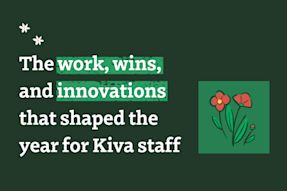
Do you have a question that isn't answered here? Check out our Help Center here.
What is the difference between flexible funding and fixed funding models?
How can I tell which loans are flexible vs fixed funding model?
What does “ending soon” mean?
How does flexible funding create more impact?
What are currency exchange losses and gains?
How do currency losses and gains affect my account?
How will taking on currency risk by lenders lead to more impact?
How can I minimize my risk of currency loss?
Why is Kiva starting to charge Field Partners platform service fees?
What is the difference between flexible funding and fixed funding models?
In an effort to maximize the amount of money sent to borrowers, in many cases we send partially-funded loans to the field. Each loan page will indicate under “Loan details” whether the loan has a fixed or a flexible funding model.
Fixed funding - the full amount of the loan must be raised within 30 days in order for the funds to be sent to the field. If the loan doesn’t reach its goal, any amount raised will be refunded to contributing lenders.
Flexible funding - whatever amount is raised within 30 days will be sent to the Field Partner, regardless of whether the full loan amount is raised. The Field Partner will use other sources of funding to provide the remaining amount for the borrower.
How can I tell which loans are flexible vs fixed funding model?
Each loan page will indicate whether it has a flexible or a fixed funding model under “Loan details.”
Over the next few years, we’ll be adding this flexible fundraising option to more loans in Kiva's portfolio and experimenting with how this works. Flexible fundraising is not available for Kiva US loans or in cases where the Field Partner prefers the fixed model or is not able to cover the remaining loan amount not raised on Kiva.org.
What does “ending soon” mean?
To increase the amount of capital we send to borrowers, we are changing our policy requiring every crowdfunding loan to hit 100% of its goal. Loans will still have 30 days to fundraise on our platform. However, for qualified Field Partners, we’ll send them the amount raised within the period even if loans do not hit their goal. Loans nearing the end of their 30-day fundraising period have previously been labeled “Expiring soon.” This will change to “Ending soon.” Loans in their final five days of the funding period are not eligible to be reserved in lenders’ baskets to help maximize the amount raised.
How does flexible funding create more impact?
We wish every Kiva loan could be funded in full, but the marketplace nature of Kiva means that this isn’t the case. To maximize social impact and efficiency in fundraising, we're shifting our fundraising process to allow for partial funding.
Because most loans are pre-disbursed, borrowers will not feel the difference in funding strategies. Field Partners will use other sources of funding to cover the loan amount that the borrower requests. Field Partners will also be able to choose when the fixed approach is more appropriate for a particular loan product.
Posting loans to the Kiva website takes diligent effort for Field Partners and our team of volunteer editors and translators. We don’t want these efforts to be wasted. Flexible funding will ensure that most loans posted yield partial funding. Our hope is that this approach will ultimately deploy more money overall to the field, which will help our Field Partners expand their reach and impact.
What are currency exchange losses and gains?
You might be seeing "currency exchange loss" or "currency exchange gain" in your repayments emails. Here's how that works.
All Kiva loans are made to Field Partners in US dollars. Field Partners, in turn, give the funding to borrowers in their local currency. While the borrowers repay the Field Partner the amount due in their currency, our Field Partners send the amount due to Kiva in US dollars.
That means that Field Partners are accountable for losses in the currency exchange process. If local currencies fluctuate and lose value during the course of a Kiva loan, Field Partners must use more of their local currency in order to repay Kiva in US dollars. This increases the cost of borrowing from Kiva. Managing this currency risk takes an operational toll on our Field Partners and it can hinder their ability to work with new borrowers or post more loans on Kiva’s platform.
Until August 2019, all Field Partners covered the first 10% of currency losses while Kiva lenders covered the rest. Now, to help Field Partners reduce risk, stabilize cash flow and facilitate more loans, select Field Partners have the option to pass all currency risk on to Kiva lenders.
Kiva now offers Field Partners 2 models for currency risk. The first currency loss option still requires Field Partners to assume the first 10% of currency risk, while the new risk option passes all of the currency risk to lenders. Each loan page will indicate which option applies in the loan details section under “Partner covers currency loss?”
Absorbing these losses on the lender side protect the partner and its borrowers from harmful currency devaluations that could hurt their ability to serve borrowers.
Still want to know more about how currency risk affects Kiva? Read on here.
How does currency loss or gain affect my account?
For context around currency exchange, see What are currency exchange losses and gains?
Because Kiva lenders now assume currency exchange loss for Field Partners, Kiva is exposed to both currency losses and gains. Once a loan has been repaid in full, any currency gains will help offset any losses incurred for that specific loan. Because Kiva loans are not investment vehicles capable of earning a profit, any excess foreign exchange gains will be retained in a Kiva account that will be used to fund new loans.
You'll see any currency losses and gains on your loans reflected in your Repayment notifications as well as in your Kiva portfolio. While losses are reported for each monthly repayment period, gains are only reported after the loan has been repaid in full. That means that while Kiva lenders will never receive gains over losses for a specific loan, you may see gains that exceed your losses for a specific repayment period. Let us know if you have further questions at contactus@kiva.org.
How will taking on currency risk by lenders lead to more impact?
Kiva’s ultimate goal is to create opportunity for the 1.7 billion people around the world who are still financially excluded. The need for financing is often greatest in regions prone to economic instability and currency volatility. This means that Kiva often works in countries with currencies prone to fluctuation or devaluation against more stable currencies like the US dollar.
Managing this currency risk takes an operational and financial toll on our Field Partners and ultimately it can hinder their ability to offer funding to new borrowers and post additional loans on Kiva’s platform. By fully absorbing the risks associated with lending across currencies, lenders are ultimately helping Field Partners stabilize their cash flow and serve more borrowers.
How can I minimize my risk of currency loss?
Currency exchange losses will be a possibility for most loans on Kiva’s site. However, some Field Partners choose to bear this risk themselves instead of passing it on to lenders. Lenders can learn more about the level of risk associated with each loan by referring to the currency risk section on the loan profile page.
Lenders can also choose how much risk they’d like to take on by filtering their loan search in Advanced filters (kiva.org/lend) with the checkbox labeled “Exclude loans with currency risk.” This will narrow the search to loans without the risk of currency loss.
To minimize currency risk, lenders can also diversify their portfolio across various countries. This helps to limit exposure to currency losses in any one region.
Why is Kiva starting to charge Field Partners platform service fees?
Kiva's lenders and partners have created incredible impact over the past 15 years, but there are still 1.7 billion people who still do not have access to financing. This year, Kiva is stepping into a bigger role in addressing the challenge of global financial inclusion and will push ourselves to innovate more than ever.
In order to fulfill our vision of a financially inclusive world, we must invest in technologies and processes that will allow us to reach these excluded communities and maximize their opportunities to get access to loans.
Because 100% of funds lent on Kiva.org go to borrowers, Kiva relies on optional donations from lenders and foundations to fund our operations - including sending staff to the field to conduct audits, maintaining and improving the functionality of our website and supporting hundreds of volunteers.
As we seek to expand our impact, we are looking for sustainable sources of funding that will allow us to innovate and take on exciting new projects in service of our mission. Asking our field partners to contribute small service fees will help us to cover our basic needs as well as new initiatives for empowering the world’s most excluded populations.
Without the constraint of relying solely on donations, Kiva plans to use these funds to push the boundaries of microfinance and implement groundbreaking ideas for making financial support not only accessible but transformative.
PREVIOUS ARTICLE
What is currency risk protection? →NEXT ARTICLE
Kiva is taking new steps in 2019 to increase our impact →













